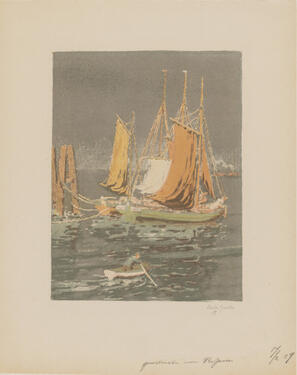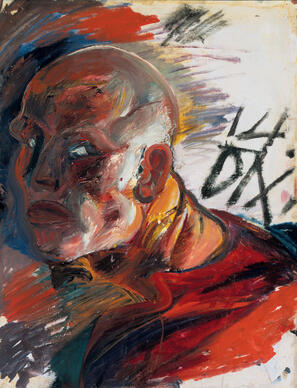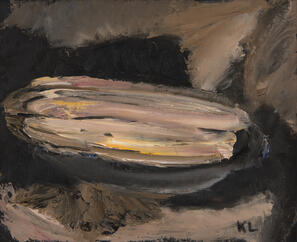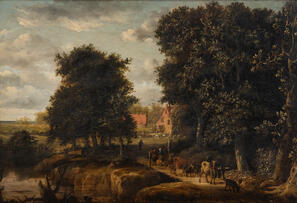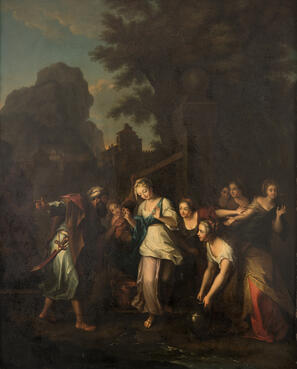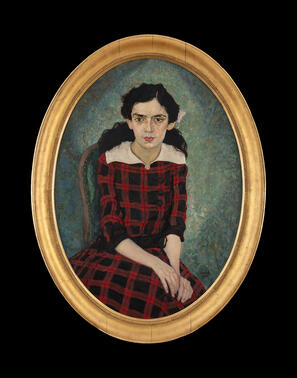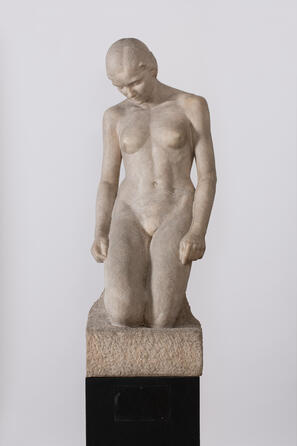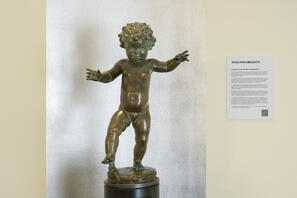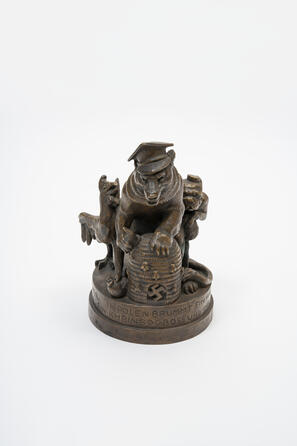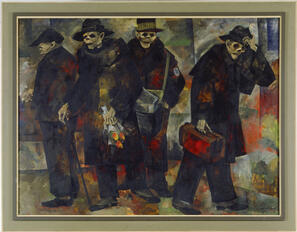Provenance Research
With ownership comes responsibility – which is why the Kunstmuseum Stuttgart has been committed to provenance research since 2014. It investigates the origin history and changes in ownership of the artworks in the collection and examines whether they include assets seized as a result of persecution by the Nazi regime. The long-term objective is to review all of the artworks acquired in the period from 1933 to 1945 and since 1945. Taking into account all of the genres represented in the collection, this entails several thousand artworks. At the same time, we are also conducting research into the institutional and collection history of the Städtische Galerie Stuttgart and, from 1961 on, the Galerie der Stadt Stuttgart – the forerunners of the Kunstmuseum Stuttgart.
Dr. Kai Artinger
Provenance Research
+49 (0)711 / 216 196 13
kai [dot] artinger [at] kunstmuseum-stuttgart [dot] de (kai[dot]artinger[at]kunstmuseum-stuttgart[dot]de)
The Kunstmuseum Stuttgart sees itself committed to the goals of the Washington Principles of 1998 and the 1999 Common Statement adopted by the German federal government, states, and municipal umbrella organizations regarding the location and restitution of cultural property, especially from Jewish ownership, confiscated as a result of Nazi persecution.
Thanks to the financial backing initially provided by the Provenance Research Office and then with funding from the German Lost Art Foundation, we were able to successfully carry out the first provenance research project from July 1, 2014, to June 30, 2017. The project was primarily devoted to the paintings of Otto Dix and a portion of the paintings acquired from 1933 to 1945.
Since 2017 the provenance research project has been continued with financial support from the City of Stuttgart. As a result, another large group of the paintings was investigated. In February 2020, the investigation began on the graphic collection of the Städtische Galerie Stuttgart established during the National Socialist era. Provenance research in this area is extremely challenging because scarcely any sources on the acquisition of graphics purchased during this period exist. The inventory lists and many other important documents were destroyed by fire in the war.
While the Kunstmuseum Stuttgart is a relatively young museum (est. 2005), the history of its origin and development is complex and complicated. The history of its forerunner institutions and especially that of the municipal collection under National Socialism have until now largely remained unexamined. Kai Artinger, in connection with his work as a provenance researcher at the Kunstmuseum Stuttgart, has closed this gap in the research for the painting collection. He has also comprehensively uncovered and detailed the history of the municipal gallery’s development and its painting collection—which you can read about in his book “Das Kunstmuseum Stuttgart im Nationalsozialismus: Der Traum vom Museum ‘schwäbischer’ Kunst”.
Results of Provenance Research and Restitution
Lost Art Database Reports
The Kunstmuseum Stuttgart has to date reported 42 paintings to the Lost Art Databank of the German Lost Art Foundation – including an early work by the Dutch landscape painter Meindert Hobbema (1638–1709) and a history painting by an unknown Dutch painter that until recently was attributed to Philip van Dijk (1683–1753). Both paintings were among the costliest postwar acquisitions. The city purchased them for 400,000 Reichsmarks from an art dealer who is suspected of having been involved in the Nazi theft of cultural goods.
Max Rosenfeld Restitution Case
Max Rosenfeld (1867-1943) was a Jewish tobacco dealer and art collector in Stuttgart. Before the First World War, his Art Nouveau villa was well known. Due to his death in the Dutch transit and concentration camp Westerbork, the destruction of his villa in World War II, and the repression of the genocide of the Jews in German post-war society, his fate and that of his family fell into oblivion.
Around 1937/38, 23 prints by the artist Carlos Grethe (1864-1913) from the Rosenfeld art collection came into the possession of the city of Stuttgart. Under what circumstances the city acquired the prints is unknown: Circumstantial evidence points to a Nazi persecution-related seizure.
Rosenfeld's younger son Paul Georg (1906-1988) emigrated with his family to the USA via the Netherlands in early December 1938. Max Rosenfeld fled to Amsterdam in August 1939, where he lived until his deportation to Westerbork in February 1943.
In 2022, the Kunstmuseum Stuttgart and the City of Stuttgart decided to return the Grethe graphic collection and a small portrait painting depicting Max Rosenfeld to his heirs, who live in the USA. This is done on the occasion of the opening of the exhibition “Graphics for the Dictatorship. The Birth of the Kunstmuseum Stuttgart’s Graphic Collection in National Socialism” at the beginning of November 2024. All 23 graphics will also be shown in the exhibition.
A current german contribution of SWR Aktuell about this can be found here.
The mysterious provenance of the ‘double Dix’
Otto Dix’s “Selbstbildnis als Soldat / Self-portrait as a soldier” (1914) (verso: “Selbstbildnis mit Artilleriehelm / Self-portrait with artillery helmet” (1914)) is among the most significant works in the Dix Collection of the Kunstmuseum Stuttgart. Its provenance, however, was not clarified until July 2021. New research reveals that this work was acquired by the young Austrian secretary Paula Risch (1897–1999) – under mysterious circumstances. She was unaware that there was a second self-portrait on the back of the painting, even though the artwork had been hanging in her home for decades.
Kai Artinger: Das Geheimnis der kunstliebenden Österreicherin Paula Risch. Die rätselhafte Herkunft des ‘doppelten Dix’, in: Kunstgeschichte. Open Peer Reviewed Journal, 2022.
The Käthe Loewenthal Restitution Case
“Spargelstillleben / Asparagus still life” (1941) by Käthe Loewenthal (1878–1942) was acquired by the Städtischen Galerie Stuttgart in 1972. Research has revealed that the painting was confiscated in connection with Nazi persecution. Under the Nazi regime Loewenthal was prohibited from working and in 1942 ultimately deported and murdered. In 2019 Loewenthal’s descendants decided that the painting should remain in the collection of the Kunstmuseum Stuttgart. As part of a fair and equitable solution, the community of heirs donated the artwork to the City of Stuttgart. With the donation, the museum committed itself to keeping the memory of the artist alive. In conjunction with the exhibition “The Dream of a Museum of “Swabian” Art. The Kunstmuseum Stuttgart in National Socialism” (February 1–November 1, 2020), the painting was exhibited, its provenance presented, and documents used to commemorate the life and work of the Stuttgart artist.
The mysterious van Dijk at the Kunstmuseum Stuttgart
On June 16, 1948, the city of Stuttgart purchased two old Dutch paintings from the art dealer Dr. Erwin Sieger for the exorbitant sum of 400,000 Reichsmark. They were a landscape by Meindert Hobbema and a supposed depiction of Jacob and Rebecca at the Well, attributed to Philip van Dijk. No expert opinions on authenticity were obtained and the art dealer Sieger was blindly trusted, even though he had been interned by the American military government in 1945 and paintings from his art collection were restituted. The examination of the two artworks revealed that the van Dijk is a replica and the authorship must be questioned. In addition, the provenance is very questionable. Against this background, questions arise: Was the extremely high price justified at the time? How should the value and significance of the paintings be assessed today? Why did the acquisition come about?
Kai Artinger: Der rätselhafte van Dijk im Kunstmuseum Stuttgart. Über einen spektakulären Gemäldeankauf der Stadt Stuttgart 1948 und ein Fall für die Provenienzforschung, in: Kunstgeschichte. Open Peer Reviewed Journal, 2020.
The Babette Marx Restitution Case
The portrait “Grete Marx” (1915) painted by Bernhard Pankok belonged to Babette Marx, the widow of a Jewish entrepreneur from Stuttgart’s Bad Cannstatt district. She had four children: the three sons Leopold, Julius, and Alfred, along with a daughter, Grete. Marx died in the Theresienstadt concentration camp; the children survived the Holocaust. Immediately following the National Socialist seizure of power, the Marx company was listed in the defamatory writings “Deutscher kaufe nicht beim Juden!” (Germans, don’t buy from Jews!) and in 1938 ’aryanized’. After the Kristallnacht pogrom on November 9, 1938, Alfred and Leopold Marx as well as other members of the family were imprisoned for a short time at the Dachau concentration camp. In 2019, the painting was restituted to the heirs now living in Israel and the United States and repurchased from them.
A Case of ’War-Related’ Confiscation: Margarete Depner’s “Die Sinkende”
The marble sculpture “Die Sinkende / The Sinking” (1933) by the German-Romanian painter and sculptor Margarete Depner (1885–1970) was purchased in 1942 at the first touring exhibition “Deutsche Künstler aus Rumänien” — although the artist never received any money for it. The work’s provenance raised questions even in the postwar period, because it was unclear whether the city had ever paid for the piece. The investigation into its origins in connection with the current provenance research revealed that this in fact had not occurred. The Depner case can be regarded as a “Nazi war-related” seizure of cultural goods. In 2019 the Kunstmuseum Stuttgart and the City of Stuttgart decided to retroactively reimburse the artist’s heirs for the fee.
Research of the museum, collection and object history
What connects the “Sportlerin / Sportswoman” (1940) with the Pragfriedhof in Stuttgart? New research findings about the sculptor Daniel Stocker
Daniel Stocker (1865-1957) rose to become one of the best-known sculptors around 1900. He created fountains, monuments, busts, memorials to the fallen, etc., which were mainly created during the German Empire and the Weimar Republic. He was the classicist sculptor par excellence.
It has been forgotten that Stocker was also involved in art under National Socialism. He exhibited several times at the “Great German Art Exhibition” in Munich. Adolf Hitler purchased a bronze statue of him in 1938 and 1939. During the Second World War, the city of Stuttgart bought his bronze sculpture “Sportlerin / Sportswoman” for the municipal art collection. And in 1938, Stocker was commissioned by the city to create one of the most radical works in his oeuvre in terms of content: the larger-than-life anti-Semitic stone sculpture “Baldur und Erde / Baldur and Earth”. It was erected in 1940 on the occasion of his birthday in the extension to the mortuary at Pragfriedhof. It still stands in the cemetery today.
Kai Artinger: Der »Völkische Messias« im Leichenhaus. Der Bildhauer Daniel Stocker und seine Plastik Baldur und Erde – Symbol »germanischen Christentums« und antisemitisches Bildwerk, in: Kunstgeschichte. Open Peer Reviewed Joournal, 2024.
Fritz Nuss' “Der erste Schritt / The first step” (1941) at the registry office Mitte Stuttgart
The bronze “Der erste Schritt / The first step” by Fritz Nuss (1907-1999), one of the best-known south-west German sculptors of the 20th century, is on display at the registry office in Stuttgart Mitte. The work was exhibited in 1942 at the “Great German Art Exhibition” in the “House of German Art” in Munich. The city of Stuttgart acquired it in 1950.
As an artist, Nuss adapted to the fascist regime, became a member of the NSDAP and worked very successfully not only as an artist, but also as an art functionary in the “Third Reich”. The Nazi state awarded him commissions, the title of professor and acquired works.
As “Der erste Schritt / The first step” is part of the sculpture under National Socialism, an information board now provides information about the biography of the sculptor in the “Third Reich" and the history of the creation of his sculpture. The previous presentation did not do justice to the historical context and state of research on art under National Socialism. The QR code on the plaque links to a digital room of the Kunstmuseum Stuttgart / Collection Online, which provides further detailed information about Nuss, his sculpture and the history of the Kunstmuseum Stuttgart's sculpture collection under National Socialism.
The unknown side of the Stuttgart sculptor Josef Zeitler (1871-1958): Research on his Nazi propaganda sculpture “In Polen brummt ein wilder Bär / A wild bear is roaring in Poland” (1939).
The Kunstmuseum Stuttgart recently investigated the history of the beginnings of its sculpture collection. The National Socialists built it up against the backdrop of the founding of the Stuttgart Municipal Art Museum. The old inventory of sculptures burned during the destruction of the city of Stuttgart's art protection camp shortly before the end of the war. Sculptures were also destroyed, among others by the sculptor Josef Zeitler. Because very few documents have survived, it is difficult to fully reconstruct the creation of the sculpture inventory and its composition.
In the course of researching the inventory, a very unusual Nazi sculpture by Josef Zeitler has now been examined for the first time, about which nothing was known until recently, except that it was purchased by the city of Stuttgart from the Württenbergischer Kunstverein Stuttgart (WKV) for a project entitled “Zeitgeschichte 1981” and later integrated into the Kunstmuseum Stuttgart's sculpture collection. Inventoried with the title “Kriegsplastik”, the sculpture is an example of Nazi propaganda art and the only work of its kind that the Kunstmuseum Stuttgart owns. Why the museum accepted it, although it has never been exhibited since, and why the WKV kept Nazi propaganda art in its art holdings until 1981 are just some of the questions to which art historian and provenance researcher Kai Artinger attempts to provide answers in an essay. They include why a Stuttgart artist made a three-dimensional caricature of the defeated nation after the German invasion of Poland on September 1, 1939 - a sculpture that seems to be unique in ‘Third Reich’ art because nothing comparable can currently be placed alongside it.
Kai Artinger: In Polen brummt ein wilder Bär (1939). Die merkwürdige NS-Plastik des Stuttgarter Bildhauers Josef Zeitler, in: Kunstgeschichte. Open Peer Reviewed Journal, 2023.
Fear in the Third Reich. Hermann Sohn's “Die schwarzen Männer / The black men” (1934) and the question of resistance
The painting “Die schwarzen Männer / The black men” (1934) by the Württemberg painter Hermann Sohn (1895-1971) is one of the most enigmatic contributions to German art in the Third Reich, unknown outside of south-west Germany. The artist kept it hidden for decades. When it was exhibited in 1985, it was declared an ‘incunabulum of Swabian resistance painting’ and ‘one of the very few truly anti-fascist paintings of the time’. However, in 1933 Sohn had also produced the painting “Deutsches Turnfest 1933”, in which he captured the major Nazi propaganda event in Stuttgart. This painting found favor with the city's rulers, who purchased it in December 1934 for the Stuttgart Municipal Gallery. In 1935, the ‘Fibel für die Volksschulen Württembergs’, a new reading book published by the Nazi government, was published, in which Sohn collaborated as an illustrator. A year later, he applied for a teaching position at the art academy in Stuttgart, which had been brought into line with the Nazis, but was unsuccessful. In view of the contradictions and ambivalences in Sohn's life and work, the question arises as to how “Die schwarzen Männer / The black men” should be interpreted.
Kai Artinger: Fear in the Third Reich. Hermann Sohn's ‘The Black Men’ (1934) and the question of resistance, in: Kunstgeschichte. Open Peer Reviewed Journal, 2020.
